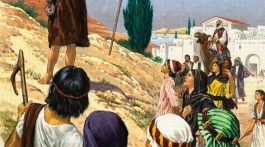From June 6-11 this year, delegates from every union conference of the Seventh-day Adventist denomination will gather for the 61st constituency session of the General Conference, either virtually or in-person in St. Louis, Missouri. This session has been delayed twice due to the global pandemic, but will now proceed with the allowance of virtual participation, as voted during a specially called GC session at church headquarters last January.1
The Seventh-day Adventist GC Session, usually held every five years, is the largest official denominational meeting in the world. Approximately 2,700 voting delegates will represent more than 21 million church members from over 200 countries. Approximately 6% of the delegates will be from North America. The sessions will be live streamed around the world from www.gcsession.org.
Why is holding a session important?
Administrative meetings might sometimes seem irrelevant or an unwise use of so much time, money and energy. What is the benefit to a local church member? Can members have any influence on what is voted? The answer lies in understanding that the Seventh-day Adventist Church is an interconnected global community of interlocking and interdependent systems that directly and indirectly impact each other. We are like a living organism, and if one part of that ecosystem fails or dominates we will have problems fulfilling our mission.
How is church business accomplished?
The Adventist Church is run by governance committees and boards–beginning at the local congregation and weaving through all the other church segments. The most important decisions are always made by groups. Your church board uses the Church Manual and the NAD Policy Book, which is one way votes taken during the GC session could impact your local church. Another way is through votes regarding the percentage of tithe that goes “over” through the funding process and comes “back” to the conferences—not “up and down” because the Adventist Church is not organized as a hierarchy.
“Committees and constituency sessions allow for a certain amount of accountability and democracy that a top-down system wouldn’t,” said Kaleb Eisele, co-producer of a podcast called How the Church Works. “When our system works as it was designed, decisions around church policy are made collectively by the people we choose to represent us.”2
Who are our delegates to the GC Session?
Delegates are selected by each union executive committee around the world to represent their territory. Mid-America’s 16 delegates have been carefully chosen based on their track record of experience and service, while still achieving the ratios required by the GC of gender, race and lay member or church employee.
- Roger Bernard, president, Central States Conference
- Ron Carlson, president, Kansas-Nebraska Conference
- Dean Coridan, president, Iowa-Missouri Conference
- Alejandro Dovald, pastor, Lincoln Hispanic Church (NE)
- Delvin Hansen, member, Harvey Church (DA)
- Debbie Jackson, member, Denver Park Hill Church (CO) (Central States)
- Sharmani Long, member, Franktown Church (CO)
- Justin Lyons, president, Minnesota Conference
- Cynthia Mochama, member, The Way Church (MN)
- Hubert Morel, vp for administration, Mid-America Union
- Abelardo Rivas, pastor, Multicultural Church for the Community, (MO)
- Vinita Sauder, president, Union College
- Gary Thurber, president, Mid-America Union
- Mic Thurber, president, Rocky Mountain Conference
- David VandeVere, vp of finance, Mid-America Union
- Mark Weir, president, Dakota Conference
Only delegates and invitees are allowed voice during business sessions and only delegates may vote. This year’s agenda is typical, calling for elections, a review of fundamental beliefs and policies, and a review of the GC constitution and the Church Manual—items that can only be voted on during a session.
What’s different this year?
In addition to accommodating virtual participation by delegates, there will not be any ancillary meetings or exhibits or booths. There will, however, be a virtual exhibition hall. Delegates are encouraged to attend in person, if possible. Yet it seems likely that some countries will only be represented virtually, meaning that the diversity usually displayed in the stadium will be lacking.
The 67,000-seat stadium (America’s Center Convention Complex) will be open to the public during the business meetings and on Sabbath. However, due to the pandemic and the change of location from Indianapolis to St. Louis, many of the community service activities and evangelistic events that usually accompany a GC session will not be happening in 2022.
Why St. Louis?
America’s Center is conveniently located in the heart of downtown St. Louis, close to hotels, dining and public transportation. The city has an international airport and can comfortably house the large number of delegates. The 58th session was also held in St. Louis in 2005, and the 62nd session in 2025 is scheduled again for St. Louis. Only a handful of cities have the facilities to host the GC session, although that may change if a majority of delegates participate virtually going forward.
How does the GC Session nominating committee work?
A nominating committee is formed at the beginning to nominate GC officers and vice presidents, departmental directors and associate directors, and officers of the 13 divisions, which are extensions of the GC. Delegates from each division/attached union meet together and select 10 percent of their group to serve on the nominating committee. Delegates at large (delegates due to the GC positions they hold) select eight percent of their group to serve. Around 250 people serve on the nominating committee.
1) Each division delegation acts as a unit in selecting the representatives to which it is entitled. It is customary for union presidents to be elected to serve on this committee, particularly if the union is entitled to only one representative.
2) Election to the nominating committee is done by the method of voting considered by each delegation to be most convenient and efficient (this year it will likely be done virtually).
3) No delegate may nominate more than one person for election to the nominating committee.
4) Once established, the nominating committee elects its own chair and secretary under the temporary chair of the GC president whose term is expiring.
5) In order to expedite the work of the nominating committee, representatives from each division meet together and consider the personnel needs of their respective divisions and then make recommendations to the full nominating committee. Decisions of these groups are not binding; they are only recommendations.
6) The GC president is elected by all the delegates first, then joins the nominating committee to offer recommendations on all the other nominations, which the committee may choose to accept or reject.
7) It is traditional practice for the nominating committee to consider incumbents first, and then to bring only one name at a time for each position (including president) to the delegates, who either approve the name or send it back to the committee.
Where does accountability lie?
The highest level of authority at each segment of denominational organization is within the constituency session. In addition, each officer is accountable to the organization’s executive committee. An executive committee (or board, in the case of institutions) is entrusted through policies or constitutions and bylaws with authority to govern between constituency meetings. However, the executive committee/board members are ultimately accountable to their constituency. 3 We have checks and balances to help keep erratic leaders from hijacking the church.
What holds 21 million members together?
Simply stated, the love of Jesus Christ. “Love the Lord your God with all your heart, mind and soul.” This love undergirds our commitment to our unique 28 fundamental beliefs. It also allows us to be gracious to those with whom we may not always agree. Love grants us the knowledge that while we wait for Christ’s return we can be stronger together in spreading the amazing news that Jesus offers hope and healing to everyone.
“Today, with more people operating across the globe,the Adventist Church’s decisions must be made with increasing care for the massive spectrum of humanity they serve,” concluded Eisele. “Policies, leadership and decision-making bodies are a vital part of that process in our modern-day, and they remain an important way a local church member can participate in shaping the Seventh-day Adventist Church for future generations.” If you want to change the church for the better, volunteer to serve on your local church board, your conference executive committee or the bylaws committee. These are the most powerful decision-making groups and the most effective means of creating change processes in Adventism.
How can I get updates on what’s happening? Watch the live stream at www.gcsession.org or sign up for myOUTLOOK e-news, a free email newsletter produced by the Mid-America Union communication team that will be sent daily during the session (you may unsubscribe at any time). There will also be a summary printed in the September issue of OUTLOOK magazine.
For more information go to gcsession.org/questions
1 https://gc.adventist.org/live/2022-session/
2 Howthechurchworks.com
Adventist Church Segments and Roles *
World Church Stats** as of Dec. 31, 2020
LOCAL
Congregations: 165, 438 worldwide (of which your local church is one)
Your local church is the foundational building block of Adventism. You—and only you— vote your own membership, either by baptism or profession of faith. Your board votes your local leaders, your budget, oversees all ministries and operations, manages your ACS volunteers, Pathfinder/Adventurer clubs, health outreach and all other community services and events you choose to host. You support the mission of the church with your time, energy, resources, brain power and prayers.
AREA
Conferences/Missions: 732 worldwide (your local conference is one of six in Mid-America)
The conference is empowered by its congregations to collect the tithe and hire/pay/move full-time and some part-time church pastors and teachers at denominational schools. The conference legally owns all the church buildings, academies, elementary schools, ABCs, ACS centers and summer camps in its territory. It has its own constitution and bylaws that its constituents vote during their session every 4 (sometimes 5) years. The conference executive committee has power to vote changes at the conference level between sessions. It also has the responsibility of planting new churches in un-entered areas of its territory.
REGIONAL
Unions/Missions: 138 worldwide (Mid-America is one of 9 in North America)
Unions are empowered by the conferences to strengthen the operation of colleges and universities in their territory, manage Revolving Fund loans for churches and schools, publish the union’s official magazine, certify all denominational teachers, oversee accreditation for schools and help establish the curriculum. The union executive committee votes on recommendations for ordination from the conferences and votes the names of delegates to GC sessions.
CONTINENTAL
Divisions: 13 worldwide (of which North America is one)
The divisions, which are extensions of the GC, strengthen the unions through special funding for projects, creating resources, managing the Adventist retirement plan for employees, and coordinating division-wide events for pastors, teachers and ministry leaders.
GLOBAL:
General Conference: 1 (covers the globe)
The GC oversees the global missionary work of the Adventist Church to un-entered countries. In addition, it strengthens the divisions and unions by providing services in areas such as religious liberty, risk management, auditing and legal counsel. It produces the Adventist Review and the Sabbath school lessons. The Office of Archives, Statistics and Research gathers and shares pertinent information for the global church.
*Descriptions from gc.adventist.org
**https://documents.adventistarchives.org/Statistics/Other/SDAWorldChurchStatsSummary2020.pdf









